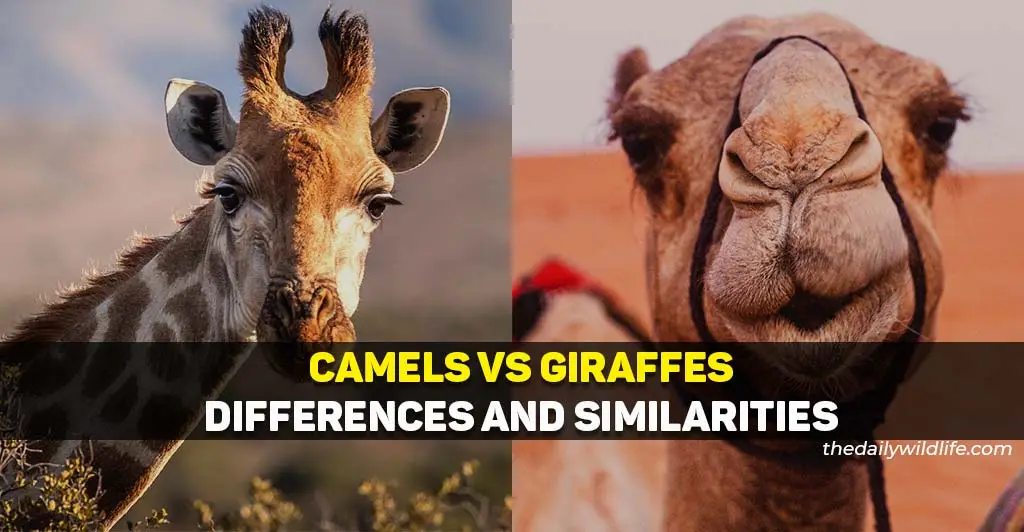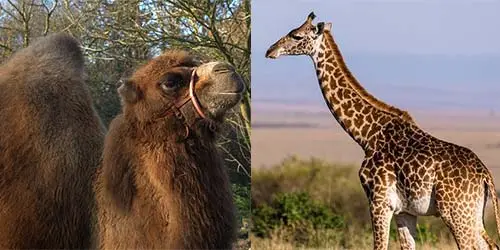Both of them have long necks and slender legs, both of them are huge animals; it is quite normal to ask: what are the other key differences and similarities between camels and giraffes?!
We will split this article into 2 parts, one examining differences, and the other examining similarities between these two animals.

Table of Contents
Major Differences Between Camels And Giraffes
1. Camels Have Fatty Humps, Giraffes Do Not
Despite giraffes having small bumps on their backs, they do not have fat tissue like camels do. Camel’s humps work as food and water storage when there’s no nourishment available.
Despite the common myth, camels do not store water in their humps; it is fat that camels transform into energy and water in the presence of oxygen. That hump can weigh up to 80 pounds (35 kg) and allow the camel to go several weeks without food and water.
On the other hand, giraffes have small bumps on their backs, but these are not humps like in camels. Because of a very long and heavy head and neck, a set of strong muscles and ligaments is required to attach them to the body. This creates a small bump and only gives the impression that a giraffe has a hump on its back.
2. Giraffes Have Horns, Camels Do Not
Giraffes are born with horn-like ossicones, bone structures on top of their head covered with fur. Both female and male giraffes have ossicles. Camels do not have horns, antlers, or ossicones.
Male giraffes use their 3 ossicones as weapons when fighting with other males; they use their heads as clubs to hit the enemy. In these fights, giraffes can damage or break their ossicones; many males will even have just a single ossicone on their heads. [1]
3. Giraffes Have Patterned Fur, Camels Usually One-Colored
The fur color of giraffes varies from animal to animal but generally consists of a dark-red, brown, or nearly black color on a buff background, separated by white or cream-colored lines. Their coat has a very distinct pattern that does not continue below the knees; the belly has no spots either.

Camel’s fur, on the other hand, is usually yellow, orange, or reddish but can also go from brown to grey and black color, depending on the species. White-colored camels also exist but are very rare and hard to find. This light-colored fur reflects sun rays away from the body and helps preserve water during a drought.
4. Camels Are Mostly Domesticated, Giraffes Live In The Wild
Giraffes are wild animals that live in the semi-arid savannah and savannah woodlands of Africa. Camels are mostly domesticated animals that live in deserts and steppes of Africa, Asia, the Middle East, and Australia.
Dromedary is the largest population of camels in the world. Most of them are domesticated and live in North Africa and the Middle East. A feral population of dromedary camels lives in Australia, around 300,000 of them.
Bactrian camels are native to the Gobi Desert in China and the steppes of Mongolia. The only true population of wild camels is the Wild Bactrian one, with around 1,000 of them roaming northwestern China and southwestern Mongolia. They are critically endangered.
Giraffes are found in different habitats scattered throughout sub-Saharan Africa. Scientists estimate that there are around 70,000 giraffes in total in the wild; two of their subspecies have been listed as Critically Endangered by the International Union for Conservation of Nature (IUCN).
5. Giraffes Have A Four-Chambered Stomach, Camels Three-Chambered One
Giraffes are ruminants and have a stomach with four compartments that digests the leaves, shoots, fruits, flowers, and even twigs they eat. Camels are pseudo-ruminants; they have a stomach with three compartments to digest food.
Giraffes, like cows, sheep, and deer, have a stomach that consists of a rumen, reticulum, omasum, and abomasum. The rumen was the largest compartment followed by the abomasum, then the reticulum, and the omasum. [2]
Camels have stomachs with 3 parts. These parts are the forestomach or rumen, reticulum, and abomasum; compared to giraffes, camels lack the separation of omasum and abomasum.
6. They Have Different Hooves
Camels and giraffes are even-toed ungulates that bear their weight on 2 of their digits, third and fourth. When it comes to hooves, giraffes have fully formed ones, while camels have padded feet with small nails on top that only resemble a hoof.

The giraffe’s hooves are extremely hard and flat to the ground, with the fetlock almost touching the ground. [3]
Camels have wide and padded feet that are split in half and joined underneath by webbing to prevent the animal from sinking into the sand. At the bottom of their feet, there is a protective sole, and inside their feet, towards the heel, there is a thick ball of fat. Each toe has a toenail at its top.
7. Giraffes Do Not Spit Like Camels
Camels and llamas are famous for their spitting abilities. They will bring up the content of their stomach, mix it with saliva and spit out at the danger. Most of the time, camels will not spit, they mostly do it when they feel threatened or agitated. It is also a tactic to surprise or distract the enemy.
Giraffes do not spit like camels or llamas. Giraffes can drool a lot though, their saliva is very thick, but spitting is not something they do.
8. Giraffes Sleep Much Less Than Camels
In captivity, adult giraffes will sleep as much as four and a half hours a day. In the wild, giraffes might only sleep about 30-40 minutes a day. They will often do brief naps that last about 3-5 minutes at a time. Camels, on the other hand, sleep between 6 and 7 hours a night.
Scientists speculate that the short amount of sleep is because of predators; less sleep means less chance of getting caught. Also, because of their size, it makes it hard for giraffes to get up or get down on the ground. Some mention that they spend a lot of time chewing their cud to help digest the food. Giraffes just don’t have enough time to eat the number of calories they need, digest them, and sleep.
Camels sleep in a kneeling position, with legs folded under their body and their head and neck resting on the ground. Some stretch and sleep with their front legs spread in front, while others might sleep on the side, or even standing up!
Similarities Between Camels And Giraffes
1. Camels And Giraffes Are Both Warm-Blooded Mammals
Camels and giraffes are both mammals and members of the Artiodactyl order. They share some relation as they belong to the same order but camels and giraffes are not that closely related. Camels and giraffes are both warm-blooded animals; they need to maintain a relatively constant body temperature.
Camels, when hydrated, will have a body temperature ranging between 96.8 °F and 102 °F (36-39 °C). When dehydrated, it can fluctuate by 43 °F (6.2 °C), and go from 93 °F to 105 °F (34–40.7 °C).
Usually, a giraffe will have a body temperature of around 101.3 °F (38.5 °C). This temperature can vary several degrees. Just like camels, giraffes can also fluctuate their body temperature; it can go down to 96.26°F (35.7 °C) and up to 102.38°F (39.1 °C).
This is called adaptive heterothermy and helps save water and survive extremely high temperatures.
2. Camels And Giraffes Walk The Same Way
Camels and giraffes walk similarly: they move both legs on one side of their body and then both legs on the other side. This prevents the animals’ legs from hitting one another as they speed up, and allows them to have a faster, longer stride, and conserve energy.
Mature racing camels can run up to 40 mph (65km/h) in short distances or maintain a speed of 15 miles per hour (25km/h) for about an hour or two.
Giraffes can run as fast as 38 mph (60 km/h) over short distances, or around 10 mph over longer distances (16 km/h).
3. Camels And Giraffes Can Survive Without Water
Giraffes are as good as camels in their ability to conserve water. Giraffes can go weeks without drinking water, just like camelids.
Giraffes can go an extended period without water because of their digestive system. If food has over 60% of water, a 2,200 lbs heavy giraffe (1,000 kg) gets around 21 liters of water from food. [4]
Metabolic water amounts to 3.5 liters a day. Metabolic water is water created inside a living organism through its metabolism, by oxidizing energy-containing substances of food.
These two sources of water, together with their nostrils, are equivalent to 24.5 ml/kg body mass which is similar to camels, around 20 ml/kg body mass.
4. Both Camels And Giraffes Have 7 Vertebrates In Their Necks
Despite having significantly longer necks than camels, both giraffes and camels have the same number of vertebrates in their necks, 7. These bones provide mobility and stability to the neck and protect the spinal cord from injury.
Camel’s necks are between 29.5 and 59.8 inches long (75-152cm), while giraffes can have a neck up to 70.8 inches long (1.8 m). Despite the difference, they have the same amount of neck bones. The major difference is their size; giraffes, of course, have a lot bigger bones.
5. Both Camels And Giraffes Use Nostrils To Cool Down
Both the giraffe and the camel have a huge nasal area that helps them cool down their brain and prevent it from overheating.
The giraffe nasal mucosa surface area is about 7,500 cm2, while it is around 6,000 cm2 in the camel. Such large surfaces cool a network of blood vessels that move blood throughout the body.
Blood cooled in the nasal passages gets mixed with the arterial blood that is on its way to the brain and reduces its temperature. This helps cool down the brain and prevents overheating and brain damage.
6. Males, Females, And Calves Are Called The Same Way
Just like in camels, a male giraffe is called a bull, baby giraffes are called calves, and females are called cows.
Final Thoughts
This concludes our article that goes over the main differences and similarities between camels and giraffes.
Camels and giraffes are both large warm-blooded animals that walk the same way, by moving same-sided legs forward at the same time. They both have long necks and can go long without drinking water.
The main differences between camels and giraffes are the lack of hump in giraffes, the lack of horns in camels, and different fur colors. Giraffes sleep a lot less than camels, have a four-chambered stomach while camels have three-chambered one, and do not spit as camels do.
References
[1] Bercovitch, Fred B., and Francois Deacon. “Gazing at a giraffe gyroscope: where are we going?.” African Journal of Ecology 53.2 (2015): 135-146.
[2] Sauer, Cathrine, et al. “Quantitative macroscopic anatomy of the giraffe (Giraffa camelopardalis) digestive tract.” Anatomia, histologia, embryologia 45.5 (2016): 338-349.
[3] Bush, R. Mitchell. “Giraffidae.” Zoo and wild animal medicine (2003).
[4] Mitchell, G., and J. D. Skinner. “Giraffe thermoregulation: a review.” Transactions of the Royal Society of South Africa 59.2 (2004): 109-118.